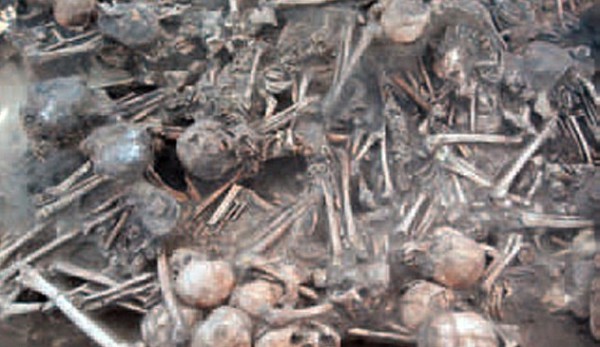In Neolithic times an apocalyptic event occurred in a tiny village in northeast China. The tiny village of Hamin Mangha contained many single-roomed houses, each with a door and a hearth. It was the home of simple people that hunted for food and grew some crops. They crafted pottery and arrow heads and they used grinding stones to make a rudimentary type of flour. They carved jade and made simple ornamentation. Their little village contained twenty-nine homes, each around twenty square meters in size and laid out in straight lines. The entire village was surrounded by a moat for protection. The people normally buried their dead in tombs and they threw their rubbish into ash pits. Hamin Mangha was a village like many others in the region; populated by a tight-knit community of people.
Almost 5,000 years later archaeologists have uncovered the remains of this tiny village and found much of it perfectly preserved. They were shocked to discover, in one of the houses dubbed F40, the skeletal remains of ninety-seven souls. The remains in the northwest side of the house are almost complete while those on the eastern side have only skulls and a few limb bones. On the southern side there were piles of limb bones two or three layers deep, and in the centre of the floor were many almost-complete skeletons scattered in a chaotic manner. It appears that this charnel house was either deliberately or accidentally set alight as some of the bones are charred and deformed. The houses in the village had wooden roof support beams; when these collapsed in the fire they damaged the skeletons in the room below.
The anthropological team, led by Ya Wei Zhou and Hong Zhu from Jilin University, examined the bones. Their research determined that the average age of the people that died was 26.8 years, with half of them aged between 19 and 35 years old. They found no remains of the extremely young or the very old. Both males and females had died in this catastrophe. So the question remains as to what caused such a disaster. Something so horrific took place that the occupants of the village could not keep up with the pace of the burials and simply chose one house into which to pile the bodies. The anthropological team noted similarities between this site and other Neolithic sites in China at Lajia and Miaozigou, where mass burials have occurred following deadly outbreaks.
Speculation is that the cause of the mass deaths was an outbreak of disease, probably a pathogen of such virility that it caused death within a very short time. The disease may have been something easy to transmit, but one wonders at the lack of remains of the very young and the elderly if this theory is to hold true. Normally the weakest members of a community are those who succumb to disease, but all the remains point to relatively young people who should have been in the prime of their lives. This calamity killed the strongest, healthiest members of the village’s residents.
Another theory put forward is that these people all died as the result of some sort of mass accidental poisoning. All the adults could perhaps have been attending a ceremony of some kind at which they drank a brew or ate food that caused accidental poisoning. There is evidence in modern times of traditional beers made from fermented grains causing mass deaths when improperly brewed and stored. Is it not plausible that something similar caused this tragedy? If so, to a simple people it must have seemed as though the Gods were very angry with them.
Whatever the cause of these deaths it must have been utterly devastating to the people of the village. A large proportion of the healthy adults of their community were suddenly missing, and the effects must have been utterly devastating to those left behind. Suddenly there was a shortage of manpower to hunt, farm and carry out all the ordinary day to day tasks. It is understandable that the village was deserted until thousands of years later, when the sun shone once again on this little encampment and its sad history.

